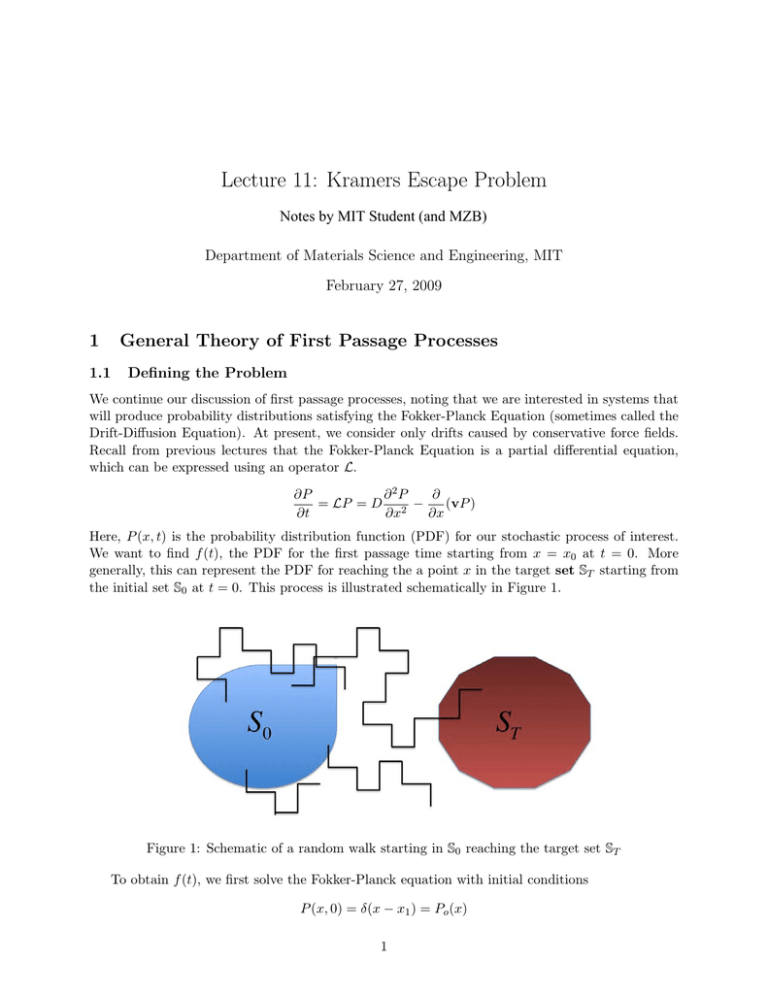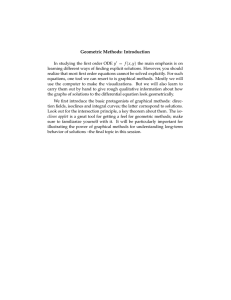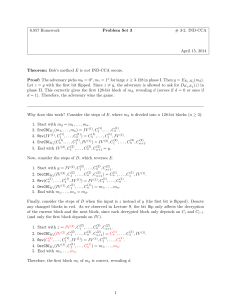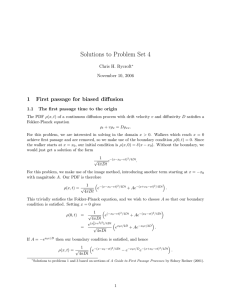Document 13488521
advertisement

Lecture 11: Kramers Escape Problem Notes by MIT Student (and MZB) Department of Materials Science and Engineering, MIT February 27, 2009 1 General Theory of First Passage Processes 1.1 Defining the Problem We continue our discussion of first passage processes, noting that we are interested in systems that will produce probability distributions satisfying the Fokker-Planck Equation (sometimes called the Drift-Diffusion Equation). At present, we consider only drifts caused by conservative force fields. Recall from previous lectures that the Fokker-Planck Equation is a partial differential equation, which can be expressed using an operator L. ∂2P ∂P ∂ = LP = D 2 − (vP ) ∂t ∂x ∂x Here, P (x, t) is the probability distribution function (PDF) for our stochastic process of interest. We want to find f (t), the PDF for the first passage time starting from x = x0 at t = 0. More generally, this can represent the PDF for reaching the a point x in the target set ST starting from the initial set S0 at t = 0. This process is illustrated schematically in Figure 1. Figure 1: Schematic of a random walk starting in S0 reaching the target set ST To obtain f (t), we first solve the Fokker-Planck equation with initial conditions P (x, 0) = δ(x − x1 ) = Po (x) 1 2 and with “absorbing” boundary condition P = 0 for x ∈ ST which eliminates all trajectories that have reached the target set. This ensures that we only count first passages. Next, we note that the survival probability S(t) is the probability that random walkers have not yet reached the target set ST . Formally, we define S(t) as S(t) = P (x, t)dx ∞ S(t) = f (τ ' )dτ ' τ which provides us the convenient relationship f (τ ) = −S ' (τ ) This means that if we can obtain S(t), we have f (t) as well, and we can calculate quantities related to f (t), for instance the moments of f (t). Here, we also note the following relationships for the first passage time PDF f (t): ∂P f (t) = − dx = − LP dx ∂t 1.2 Calculating Moments of the First Passage Time But perhaps we are only interested in the moments of the first passage time, rather than the PDF. The n-th moment is defined as ∞ (τ n ) = ∞ tn f (t)dt = − 0 tn ∂P dxdt ∂t 0 ∞ n tn (τ ) = − ∂ ∂t P (x, t)dx dt 0 1.3 Mean First Passage Time To make this all more tangible, we consider the specific case of the mean first passage time (the first moment of f (t)). Calculation of the variance (second moment) is left for Problem Set 2. Letting n = 1 in the preceding formula, we see that the mean first passage time is given by ∞ (τ ) = − t ∂ ∂t P (x, t)dx dt 0 We evaluate the outer integral by parts, obtaining ∞ ∞ (τ ) = −t P (x, t)dx + 0 P (x, t)dxdt 0 Bazant – 10.95/18.325 Mathematical Modeling of Electrochemical Systems – 2009 – Lecture 11 3 Here, we argue that the first term is zero. This amounts to arguing that as t → ∞ the probability density becomes vanishingly small at any single position x. The t = 0 limit clearly evaluates to zero. This leaves Z∞ Z (τ ) = P (x, t)dxdt 0 Now, we switch the order of integration, obtaining ⎛ ⎞ Z Z∞ ⎠ dx P (x, t)dt (τ ) = ⎝ 0 and we define the inner integral as the function g1 (x) Z∞ g1 (x) = P (x, t)dt 0 Here, we see that we have reduced the problem of calculating (τ ) to the problem of finding g1 (x). To find g1 (x), we use the following trick: we apply the Fokker-Planck operator, L, to both sides of the equation defining g1 (x). Assuming we can take L inside the integral, we have Z∞ Lg1 (x) = LP (x, t)dt 0 Recall that LP = ∂P ∂t Making this substitution, we have Z∞ Lg1 (x) = ∂P (x, t) dt = P (x, t)|∞ 0 = −P (x, 0) ∂t 0 Noting our initial condition, we find Lg1 (x) = −δ(x) Now, we can also evaluate Lg1 (x) by applying the definition of the operator L. Assuming we have a conservative force field, F = − ∂U∂x(x) , we have � ∂ 2 g1 1 ∂ � ' Lg1 (x) = D + U (x)g1 2 ∂x kT ∂x which can be rearranged as ⎡ Lg1 (x) = D ∂ ⎣ ∂g1 + g1 ∂x ∂x ∂ � U � (x) kT ∂x � ⎤ ⎦ 4 Using an integrating factor, we can further simplify this expression to U � � −U ∂ ∂ Lg1 (x) = D e kT e kT g1 ∂x ∂x Now we see that we have obtained the relationship � U � −U ∂ ∂ kT D e e kT g1 = −δ(x) ∂x ∂x Using the Fundamental Theorem of Calculus, we can unravel these successive derivatives to invert the expression and obtain g1 (x). Doing so, we find y ⎡ ⎤ ZxA Z −U (x)/kT e δ(z)dz ⎦ dy g1 (x) = eU (y)/kT ⎣ D x 0 Where y and xA are chosen to satisfy the boundary conditions of the problem at hand. Also, note that the integral over “half” of a delta function evaluates to 12 . This expression also corrects the sign error from lecture. 2 Kramers Escape Problem Now we come to the problem at hand: escape from a symmetric one-dimensional potential well due to a random walk caused by thermal fluctuations. The shape of the well is shown schematically in Figure 2 below. Figure 2: Schematic of our symmetric potential well The relevant boundary condition is P (xA , t) = 0 Bazant – 10.95/18.325 Mathematical Modeling of Electrochemical Systems – 2009 – Lecture 11 5 which implies g1 (xA ) = 0 To solve for the mean first passage time, we need g1 (x) for |x| < xA so that we can evaluate the integral Z (τ ) = g1 (x)dx Using the expression we obtained for g1 (x), we have 1 (τ ) = 2D ZxA −U (x)/kT e −xA ZxA eU (y)/kT dydx x Noting the symmetry of the well, we can split the domain of the outer integration 1 (τ ) = D ZxA ZxA −U (x)/kT e eU (y)/kT dydx x 0 Finally, we can remove dimensions from the problem by normalizing the barrier height, defining Ũ = Which leaves us with 1 (τ ) = D U E ZxA ZxA −(E/kT )Ũ (x) e e(E/kT )Ũ (y) dydx 0 x We end here, but note that we will be interested in considering the limit E kT → ∞. References [1] M.Z. Bazant. 18.366 exam 2, problem 3. 2005. [2] J.F. 18.366 lecture 15: Motion of brownian particles in energy landscapes. 2005. [3] Kenny Kamrin. 18.366 lecture 17: Return and first passage on a lattice. 2005. [4] Mustafa Sabri Kilic. 18.366 lecture 16: First passage in the continuum limit. 2005. [5] Kirill Titievsky. 18.366 lecture 18: First passage in higher dimensions. 2005. MIT OpenCourseWare http://ocw.mit.edu 10.626 Electrochemical Energy Systems Spring 2014 For information about citing these materials or our Terms of Use, visit: http://ocw.mit.edu/terms.





